William Austin Burt
William Austin Burt (June 13, 1792 – August 18, 1858) was an American scientist, inventor, legislator, millwright, justice of the peace, school inspector, postmaster, judge, builder, businessman, surveyor and soldier. He first was a builder of sawmills, but his main interest was that of surveying. He built sawmills in an area that is now the city of Port Huron, Michigan. He built an excellent reputation for his accurate surveying work on public lands. He became a government deputy surveyor and trained many young men in several states how to become professional surveyors. He surveyed boundaries in the states of Michigan, Wisconsin, Minnesota, and Iowa starting as early as 1833. He involved his five sons in surveying and each became a government deputy surveyor.
William Austin Burt | |
|---|---|
 sketch, before 1873 | |
| Born | William Austin Burt June 13, 1792 |
| Died | August 18, 1858 (aged 66) Detroit, Michigan |
| Resting place | Elmwood Cemetery (Detroit, Michigan) |
| Nationality | American |
| Occupation | Surveyor |
| Employer | United States government |
| Known for |
|
| Title | Hon. Wm. A. Burt |
| Political party | Jeffersonian Republican |
| Spouse(s) | Phoebe Cole |
| Children | 5 boys |
Burt was a promoter of the construction of the Sault Ste. Marie Canal, a shipping navigational lock to bypass the rapids on the St. Marys River. He contributed in its surveying and construction. In addition he was associated with the surveying of the Upper Peninsula of Michigan in general. He was the prime surveyor that settled the boundary disputes between Michigan and Wisconsin.
Burt was an inventor and patented several key items in the 19th century, derivatives of which are still being used in the 21st century. His 1829 typewriter is the first constructed in America with a patent. It was later destroyed in a fire. His great grandson built a model of it for the 1893 Chicago's World's Fair based on a parchment copy of the original patent. This model went through various hands and ended up at the Smithsonian Institution in Washington, D.C.
Burt's solar compass for surveying was invented out of need for a compass that was not affected by large iron deposits in a land district. He first encountered in Michigan the problem of the needle in a normal magnetic compass fluctuating erratically in all directions. This interference of course didn't allow surveying of the area. This was due to a large deposit of iron ore in Marquette County, Michigan. It turned out to ultimately be the Marquette Iron Range and mining towns sprung up in the county to get the iron ore.
Burt's equatorial sextant for navigation was invented out of need for an accurate way to know exactly where a ship was located in the world. He applied the basic design of his solar compass of using the sun as a reference and could determine a ship's azimuth, altitude, time, and declination with greater accuracy than the normal magnetic compass then used.
Biography
Ancestry
| Burt family tree showing relationships and the complete American family line of the Burts from the progenitor | ||||||||||||||||||||||||||||||||||||||||||||||||||||||||||||||||||||||||||||||||||||||||||||||||||||||||||||||||||||||||||||||||||||||||||||||||||||||||||||||||||||||||||||||||||||||||||||||||||||||||||||||||||||||||||||||||||||||||||||||||||||||||||||||||||||||||||||||||||||||||||||||||||||||||||||||||||||||||||||||||||||||||||||||||||||||||||||||||||||||||||||||||||||||||||||||||||||||||||||||||
|---|---|---|---|---|---|---|---|---|---|---|---|---|---|---|---|---|---|---|---|---|---|---|---|---|---|---|---|---|---|---|---|---|---|---|---|---|---|---|---|---|---|---|---|---|---|---|---|---|---|---|---|---|---|---|---|---|---|---|---|---|---|---|---|---|---|---|---|---|---|---|---|---|---|---|---|---|---|---|---|---|---|---|---|---|---|---|---|---|---|---|---|---|---|---|---|---|---|---|---|---|---|---|---|---|---|---|---|---|---|---|---|---|---|---|---|---|---|---|---|---|---|---|---|---|---|---|---|---|---|---|---|---|---|---|---|---|---|---|---|---|---|---|---|---|---|---|---|---|---|---|---|---|---|---|---|---|---|---|---|---|---|---|---|---|---|---|---|---|---|---|---|---|---|---|---|---|---|---|---|---|---|---|---|---|---|---|---|---|---|---|---|---|---|---|---|---|---|---|---|---|---|---|---|---|---|---|---|---|---|---|---|---|---|---|---|---|---|---|---|---|---|---|---|---|---|---|---|---|---|---|---|---|---|---|---|---|---|---|---|---|---|---|---|---|---|---|---|---|---|---|---|---|---|---|---|---|---|---|---|---|---|---|---|---|---|---|---|---|---|---|---|---|---|---|---|---|---|---|---|---|---|---|---|---|---|---|---|---|---|---|---|---|---|---|---|---|---|---|---|---|---|---|---|---|---|---|---|---|---|---|---|---|---|---|---|---|---|---|---|---|---|---|---|---|---|---|---|---|---|---|---|---|---|---|---|---|---|---|---|---|---|---|---|---|---|---|---|---|---|---|---|---|---|---|---|---|---|---|---|---|---|---|---|---|---|---|---|---|---|---|---|---|---|---|---|---|---|---|---|---|---|---|---|---|---|---|---|---|---|---|---|---|---|---|---|---|---|---|---|---|
| ||||||||||||||||||||||||||||||||||||||||||||||||||||||||||||||||||||||||||||||||||||||||||||||||||||||||||||||||||||||||||||||||||||||||||||||||||||||||||||||||||||||||||||||||||||||||||||||||||||||||||||||||||||||||||||||||||||||||||||||||||||||||||||||||||||||||||||||||||||||||||||||||||||||||||||||||||||||||||||||||||||||||||||||||||||||||||||||||||||||||||||||||||||||||||||||||||||||||||||||||
Early life
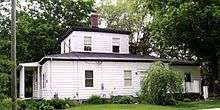
Burt was the fifth of eight children and of Scottish and English ancestry.[4] His European progenitor, Richard Burt, immigrated to America from England in 1638 or 1639 and settled in Taunton, Massachusetts.[5] Burt's parents were Alvin Burt and Wealthy (Austin) Burt of Worcester, Massachusetts.[6] He was born June 13, 1792, at his parents farm located in nearby Petersham, Massachusetts.[7][8] When Burt was six years old the family moved to Montgomery County, New York.[9] Burt's parents sold their family farm in 1802 because of poor economic times and moved to Freehold, New York.[10] In 1803 the family moved to the town of Broadalbin, New York.[11]
Burt received a total of about six weeks of formal classroom schooling in the local public schools during his childhood.[12] He was greatly influenced early in his life by his mother's virtues and religious values.[13] Burt's father sent him to the district school for a total of three weeks to begin studies in geometry, surveying, and navigation.[14] He was also home-schooled by Thomas Brown, one of their neighbors, an immigrant who at his homeland of Scotland was a college instructor.[15] Burt was eager to learn so when he was about twelve years of age he constructed a special purpose bench book holder so he could multi-task of being able to read at the same time while performing his required duty of making shingles.[15]
Burt's father gave him a book on navigation that was published in 1779 when he was about fifteen years old. He pursued studies on this on his own at any leisure moment he had from his duties he was responsible for on the family farm. He was inspired to someday become a master of a boat. Burt motivated himself to learn the traverse table and the method of determining latitude. He developed mechanical skills which enabled him to construct a quadrant instrument. With this he determined the latitude of his father's house with a good degree of accuracy, even though he had never seen a nautical instrument before. He was also interested in astronomy and studied almanacs and navigation.[5]
Burt determined from about the age of fifteen that his calling was to be such as would be useful to mankind. He studied mathematics, science, and astronomy whenever he could find books to borrow. He was from there on interested in these scientific and mathematical subjects his entire life. When Burt was about sixteen, his father sent him to school for six weeks to learn science and mathematics, which he continued on his own, even though his duties at home and on the farm were equal to other boys in his age group. Burt recalled this as he wrote about himself when he was sixty-two years old.[11]
Mid life
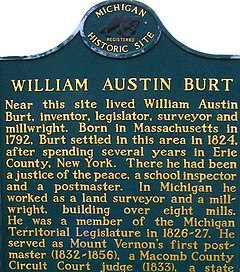
Burt's mother Wealthy lost her father, William Austin, at sea. She therefore discouraged her son from becoming master of a ship. Burt decided then to apply his science and mathematical knowledge and bought a broken surveying compass when he was eighteen years old in 1810 to see what he could do with it.[16] He repaired it and surveyed the vicinity of where his father had farm land since 1809.[17] This was near East Aurora in Erie County, New York.[11] In 1812, he enlisted in the United States army,[16] which interrupted his surveying work for a while.[5]
Burt then after the war lived in Wales Center of Erie County.[8] He held several public offices while there, with some being: justice of the peace, school inspector, postmaster, builder, and county surveyor.[6] In 1817, at the age of 25, Burt traveled for 81 days to the far west. He went on his journeys mostly on foot, but some parts he had to use small boats or horses. His travels took him to the cities of Pittsburgh, Cincinnati, and St. Louis. He eventually took a northerly route by horse through Illinois and Indiana to Detroit, then by boat to Buffalo.[18]
Burt left on August 13, 1817, by boat from the outlet of the Chautauqua Lake on the westernmost part of the state of New York and navigated south into the Allegheny River in Pennsylvania. From these he traveled to the Ohio River in Pittsburgh and down the river to the great rapids of the river at Jeffersonville, Indiana.[18]
These travels were preparatory to the time when he hoped to become a government deputy surveyor. Meanwhile, his career was the trade of a millwright in the state of New York.[11] Burt, at the age of 32 in 1824,[8] moved to Michigan from where he lived in Massachusetts.[19] He came into the acquaintance of influential prominent men who urged him to settle in the city of Detroit. There he lived and worked building sawmills and grist mills.[6] He traveled up the St. Clair River in 1825 to an area that is now the city of Port Huron.[20] There he built mills on the Black River for businessman Robert Smart.[21] Smart named them Clyde Mills after the River Clyde of his native Scotland. In 1827, Connecticut-born Detroit merchant Ralph Wadhams bought the mills from Smart and later in 1829 moved there from Detroit. This was when Smart, together with Wadhams and Detroit politician John Biddle became interested in the pine lands of St. Clair County to exploit them for lumber.[20] The sawmills ultimately became a significant business of the district and in time they became known as Wadhams' Mills since Ralph Wadhams spent the remainder of his life living there - 48 years.[22]
Burt preferred the country life for his wife and sons. When he was 41 years of age he was appointed a deputy surveyor for the United States government. At that time in 1833 three sons, John, Alvin and Austin, were old enough to work as assistant surveyors to learn the trade. In the next 18 years, all five of his sons became government deputy surveyors. He trained scores of other boys in surveying techniques at Mount Vernon, in Macomb County, Michigan. Burt was also a trainer of surveying techniques to young men in the states of Wisconsin and Iowa.[11] He surveyed the boundary between Minnesota and Wisconsin as well as the sites for Milwaukee, Wisconsin, Davenport, Iowa, and Dubuque, Iowa.[23]
Burt spent two surveying seasons in Iowa, during 1836–37 and 1842–43. There he ran the course of the fifth principal meridian in Iowa. Burt used his solar compass for the first time in 1836. Alvin, one of his sons, surveyed the boundary line between Iowa and Minnesota with this same instrument. He also surveyed Township and Range lines in Wisconsin from 1840 to 1842, where his five sons also worked.[24] Wisconsin and Michigan disputed over boundary lines, so to settle the matter Burt was selected to make a re-survey of the interstate boundary. He was the first United States linear surveyor in the Upper Peninsula of Michigan.[11]
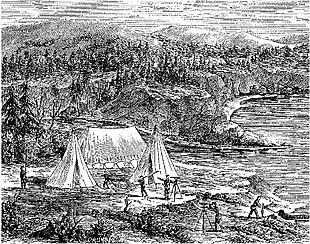
Burt discovered the Marquette Iron Range in Marquette County of the Upper Peninsula of Michigan in 1844.[25] He worked closely with state geologist Dr. Douglass Houghton on iron ore samples.[26] He took over his geological notes after his death in 1845 to complete the surveying work started. Burt noticed that the needle of a magnetic compass would spin violently in some locations in the vicinity. He persevered however, in his survey of the area using a solar compass he devised. He had realized the normal magnetic compass would not furnish accurate readings owing to the large iron ore deposits of the area. The compass needle was magnetized and would point in the direction of a large iron deposit, which generally was in a northerly direction. That idea was fine except where there were vast deposits of iron all around a local land territory. This was the case in the Upper Peninsula of Michigan, so the magnetic compass was completely useless there.[27] The Great Lakes iron range that Burt discovered in his surveying work yielded 80 percent of the nation's ore production.[28]
Burt's solar compass innovation had good accuracy in all situations because it relied on the sun's rays only and not affected by any mineral deposits. It was so accurate and reliable that it replaced the normal magnetic compass used by surveyors. Burt became prominent and famous, not only in Michigan, but nationwide. The United States government contracted with him for surveying public lands and accepted his work as satisfactory for the final authority of determining property boundaries. Burt surveyed the township lines of where the city of Milwaukee is located. He surveyed several railroad routes between cities in the Lower Peninsula of Michigan. He was one of the prime contributors in the building of the Sault Ste. Marie Canal.[27][29][30]
Personal life
Burt in 1812 became acquainted with Phoebe Cole of Wales Center, New York. She was the daughter of John Cole, a prominent citizen of the state of New York. He married her on July 4, 1813, when he was 21 years old.[17] They had five boys, John (1814–1886), Alvin (1816–1846), Austin (1818–1894), Wells (1820–1887), and William (1825–1898).[8]
Burt was a member of the Michigan Legislature and is credited with contributing the legislation for building the Sault Ste. Marie Canal.[31] He surveyed the route of the canal in 1852.[32] It is a set of navigational water locks for ships and boats traveling between Canada and the United States. The locks are part of the shipping route from the Atlantic Ocean to Lake Superior by way of Upper Michigan. They bypass the falls in St. Mary's River at the Canadian border.[16]
Burt was a Jeffersonian Democrat, but did not actively participate in national political affairs. He was a member of the Michigan Territorial Council, 1826–1827. He served as Mount Vernon's first postmaster from 1832 to 1856. He was a Macomb County Circuit Court judge in 1833, a state legislator in 1853, and a deputy U.S. surveyor from 1833 to 1853.[33] In 1847 he assisted in establishing the exact boundaries between Michigan and Wisconsin.[32] Burt was a member of the Masonic fraternity, participating as one of the founders and the first Master of the third Masonic lodge organized in Michigan.[34] Burt was appointed as Judge of a Michigan Territorial Court, so from then on was referred to as "Judge Burt."[35]
Burt was awarded the Franklin Institute award and a Scott Legacy medal. Prince Albert, consort of Queen Victoria presented him with a gold medal at the 1851 London's World Fair for his invention of the equatorial sextant.[14]
Later life and death
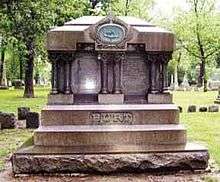
Burt moved from Mount Vernon, Michigan, to Detroit in 1857. He died there on August 18, 1858,[36] at age 66 while giving instructions to a class of sea captains on how to use the equatorial sextant, the navigational instrument he invented.[7] His remains are interred in the Burt Family lot at the Elmwood Cemetery.[37][8] The National Shorthand Association, at Detroit on August 22, 1919, unanimously voted to place a wreath on the monument over the Burt family grave in Elmwood Cemetery, honoring him as "The inventor of the first writing machine."[16][38]
Legacy
Burt is commemorated at Stony Creek, near his home in Mt. Vernon, Michigan, by a historical plaque.[39][32] Burt Lake in Cheboygan County, Michigan, is named after him, as is Burt Township, Cheboygan County, Michigan.[40][41] The New York Shorthand Reporters' Association nominated him as inventor of the typewriter in the Hall of Fame of New York University.[19][42][43] The University of Michigan received Burt's original 1858 Equatorial Sextant as an heirloom to navigation and engineering from his heirs in 1909.[44][45]
Inventions
Burt made several inventions. He was the inventor, maker and patentee of a typewriter constructed in America.[46][47][48] Among many prospects he is referred to as the "father of the typewriter" by journals and magazines.[49][50][51] Burt also invented the first workable solar compass, a solar use surveying instrument, and the equatorial sextant - a precision navigational aid to determine with one observation the location of a ship out at sea.[52]
Typographer
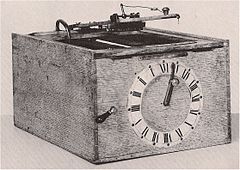
Burt's 1829 patented typographer was a predecessor to the modern-day typewriter.[53] The Burt typographer was the first constructed and operating type-writing machine patented in America.[54] The record of the patented invention in the United States patent office spells out that it is the first time in any country that a working typewriting machine was actually constructed.[55] It had a hand-operated print character assembly and an endless band paper conveyor with an escapement control.[54] The original patent was signed by President Andrew Jackson and Secretary of State and future eighth President Martin Van Buren.[54] The model of the patent was lost in the 1836 Patent Office fire.[6] Burt did research for an appropriate name for his invention and settled with "typographer" which ultimately became the hyphened word "type-writer" in 1874.[19] This was its name until the hyphen was removed in 1919, becoming then just typewriter.[7]
The typographer consisted of a wooden box with a swinging lever on one end for impressing. The typeface letters were mounted on a short sector attached on the underside of the lever. Pressing down imprinted the letter selected onto the paper. The paper was on a large continuous roll and the printed part was torn off giving the typed document or letter wanted. One could print both upper and lower case letters. The first writing machine Burt built did not live up to his expectation, so he built an improved version six months later that wasn't much faster. The improvements were mostly in looks and appearance for marketing the machine to investors. While Burt's typographer generated a lot of interest and did a very good job of typing clear and neat letters. It did not become a commercial success as his typographer was "born out of season".[56] Burt's typing machine was before a time of much need for such a machine.[14] No market was found for the device or his patent during his lifetime.[57]
Austin Burt, the great grandson of the inventor, built a working model of the typographer for the 1893 Chicago's World's Fair working from a parchment copy of the original patent (USX 558111).[7] He explained in a letter dated April 1, 1893, that was attached to the model that it took him a month to construct it from the original patent description because many of the parts had to be hand-made. The details of the construction of the machine provided by the inventor are so complete that any competent mechanic can build a working model.[58] Austin's model was on display and a picture taken of it at the University of Minnesota just prior to going to the Chicago's World's Fair in the middle of April. The younger Austin then was a student of engineering at the University.[47] The replica built by Austin was returned to the model room of the Patent Office in Washington D.C. when the Chicago's World's Fair closed. There it remained until 1903 when the Patent Office model room was closed. The "typographer" was then shipped in 1903 to Hiram A. Burt of Marquette, Michigan. Burt's machine and the original Letters Patent went to Hiram's daughter, Mrs. Howard Corning, of Bangor, Maine, when Hiram moved to Maine at a later date. The replica has been since 1922 in the Smithsonian Institution,[54] and the documents of the original letters patent stayed in the family of Mrs. Howard Corning.[38]
Solar compass
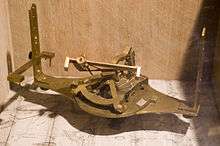
Burt was an active surveyor in Michigan, Wisconsin, Iowa and other states. He was the leader of many survey teams in Michigan, when the state was just a wilderness. His surveys revealed the rich mineral deposits of iron and copper in the state's peninsulas and the state of Michigan became a distinguished mining territory of the United States.[59] His solar compass and adaptations of it became standard instruments for the government land survey in much of the western United States and were used until the Global Positioning System was available in the late 20th century. While Burt invented the typographer typewriter, he is better known for his solar compass, invented in 1835.[48] The reason is that his surveyor's precision instrument solved many problems encountered by surveyors in the ordinary use of the magnetic compass for surveying. His precision instrument gave accurate measurements and saved individuals, states, and the United States government huge sums of money from possible lawsuits for inaccuracies due to what a normal surveyor's magnetic compass would cause in bad measurements.[14]
Burt devised the solar compass so that garbled readings caused by the Earth's magnetic field would be cleared up and true north–south survey lines could be found.[60][61] The solar compass eventually became the standard tool and was adopted by the General Land office to be used on all federal surveys, noted for its usefulness in areas of magnetic disturbance. Burt's surveying tool was used in the Michigan Survey and employed in regions that had an abundance of iron ore minerals which would interfere with accurate readings when using ordinary magnetic surveying instruments.[62] The demand for his surveying precision instrument rose dramatically. Congress would not renew Burt's patent in 1850 when it expired.[63] He claimed that he didn't even receive $300 "for his right in the invention".[64]
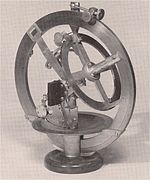
Equatorial sextant
Burt designed and invented the Equatorial Sextant for the purpose of getting quickly accurate bearings and positions of ships out at sea.[12] It was designed to know exactly where a ship was located in the world without having to do long hand time consuming mathematical calculations.[28] He was inspired to devise such an instrument while on a return trip from England aboard a windjammer.[14] When the instrument was properly manipulated it was capable of reading a ship's azimuths, altitude, time and declination with one observation. Burt applied the principles of his earlier solar compass to make this precision navigational aid that used the sun as a reference point. Other compasses of the time relied on the earth's north magnetic pole and were not reliable, causing ships to go off course. Burt's sextant was not affected by magnetism or iron ore deposits, and hence, the new sextant directed ships at sea much more true to course.[65]
References
- Cutter (1913), p. 780.
- Burt (1893), p. 513.
- Burt (1893), p. 516.
- "Relatives of Alvin Burt". Ancestry.com. Retrieved June 25, 2020.
- White (1922), p. 367.
- Cutter (1913), p. 781.
- "Replica of First Typewriter in Hands of Austin Burt, Descendant of Maker". The Courier. Waterloo, Iowa. June 17, 1922. p. 5 – via Newspapers.com.
- Smart (1962), p. 23.
- Tuttle (1873), p. 513.
- "William Austin Burt". Historical Collections. Vol. 28. 1900. pp. 644–647. Retrieved June 12, 2020.
- Fuller, pp. 175-193 William Austin Burt- inventor, by Horace Eldon Burt (Chicago) biography
- Cannon, George H. (1920). "The life and times of William A. Burt". Michigan Historical Collections. Vol. 5. pp. 115–123. Retrieved June 11, 2020.
- Fuller (1922), p. 175.
- Cox, John A. (August 9, 1953). "Patron Saint of Stenographers". Hartford Courant. p. 112 – via Newspapers.com.
- Burt (1893), p. 523.
- "The inventor of the typewriter may find a niche in the Hall of Fame". The Kansas City Times. September 11, 1931. p. 18 – via Newspapers.com.
- Tuttle (1873), p. 514.
- Tuttle (1873), p. 515.
- "Burt's name urged for Hall of Fame". The Brooklyn Daily News. September 19, 1920. p. 6 – via Newspapers.com.
- "Typewriter Inventor Pioneered Here". The Times Herald. Port Huron, Michigan. April 5, 1964. p. 8 – via Newspapers.com.
- "Salute to the typewriter". The Times Herald. Port Huron, Michigan. April 8, 1973. p. 24 – via Newspapers.com.
- "Wadhams - Region's fastest-growing commercial center attributes success to location". The Times Herald. Port Huron, Michigan. March 28, 1999. p. 145 – via Newspapers.com.
- "Iowan's forbear in Hall of Fame". The Des Moines Register. May 9, 1920. p. 8 – via Newspapers.com.
- "Early Land Surveyors left their marks". The Wakefield News. March 25, 1976. p. 4 – via Newspapers.com.
- "Survey traces are uncovered". The Escanaba Daily Press. March 9, 1976. p. 3 – via Newspapers.com.
- Traver (2014), p. 99.
- "William Burt, Michigan frontier genius". Lansing State Journal. November 26, 1981. p. 28 – via Newspapers.com.
- "World's First Writing Machine". The Sheboygan Press. October 24, 1979. p. 47 – via Newspapers.com.
- Fuller (1922), p. 183.
- Bingham (1924), p. 132.
- Reed, C. O. (September 21, 1946). "Then and Now". Petoskey News-Review. p. 3 – via Newspapers.com.
- "Ancestor of the typewriter is created". Detroit Free Press. July 22, 2007. p. 18 – via Newspapers.com.
- Tuttle (1873), p. 516.
- "Plan Tribute for H.E. Burt". Detroit Free Press. July 11, 1931. p. 5 – via Newspapers.com.
- Burt (1920), p. 9.
- "William A. Burt". The Charleston Daily Courier. August 26, 1858. p. 2 – via Newspapers.com.
- Fuller (1922), p. 180.
- Fuller (1922), p. 191.
- William Austin Burt Historical Marker
- Hannan (2008), p. 195.
- "Why Burt Lake". Petoskey News-Review. September 21, 1946. p. 3 – via Newspapers.com.
- "Nominated for Hall of Fame". The Courier. Waterloo, Iowa. June 17, 1922. p. 5 – via Newspapers.com.
- Staff (1920). "This Year's Nominations for the Hall of Fame". Scientific American. Vol. 123. p. 226. Retrieved May 14, 2020.
- Staff (1916). "Equatorial Sextant". The Michigan Technic. Vol. 29. p. 201. Retrieved June 11, 2020.
- University of Michigan (1906), p. 457.
- Fuller (1922), p. 188.
- Kidder (1920), p. 12.
- Vrooman (1923), p. 18-20.
- Kidder (1920), p. 11.
- Annual Report of the American Historical Association. Vol. 1. p. 121.
- Michigan History Magazine. Vol. 6. 1922. p. 180.
- Historical record of the Michigan Daughters of the American Revolution, 1893-1930, Volume 1
- Bonior (2001), p. 210.
- "Office Equipment / How the typewriter was developed". American Exployer. Vol. 90. 1922. p. 75. Retrieved June 28, 2020.
- "The 'inventor' of the Typewriter". The Times-Independent. Moab, Utah. February 6, 1936. p. 6 – via Newspapers.com.
- Dykema, Frank L. (1922). "A Record of the Development of the Grand Rapids Americanization Society's Plan of Citizenship Training Through the Ballot". Michigan History Magazine. Vol. 6 no. 4. p. 181. Retrieved May 14, 2020.
- Adler (1973), p. 59.
- "Burt's name urged for Hall of Fame". The Brooklyn Daily Eagle. September 19, 1920. p. 6 – via Newspapers.com.
- "Plan Tribute for H.E. Burt". Detroit Free Press. July 11, 1931. p. 5 – via Newspapers.com.
- "Solar Compass". Smithsonian Institution.
- "Burt's Solar Compass". Wisconsin Historical Society.
- Tuttle (1873), p. 520.
- "The Solar Compass Claim". Detroit Free Press. April 29, 1888. p. 28 – via Newspapers.com.
- "Solar Compass".
- "Smithsonian - Equatorial Sextant". Archived from the original on June 29, 2011. Retrieved November 10, 2010.
Sources
- Adler, Michael H. (1973). The Writing Machine: A History of the Typewriter. George Allen & Unwin. ISBN 0-04-652004-X.
- Bingham, Stephen (1924). Michigan Biographies. Michigan Historical Commission.
- Bonior, David E. (2001). Walking to Mackinac. University of Michigan Press. ISBN 978-0472-08797-6.
- Burt, Henry Martyn (1893). Early Days in New England. C. W. Bryan Company.
- Burt, Horace Eldon (1920). William Austin Burt: Inventor of Typewriter, Solar Compass, Equatorial Sextant. R.R. Donnelley & Sons. OCLC 29418708.
- Cutter, William Richard (1913). New England Family Genealogical and Memorial. Lewis Historical Publishing.
- Fuller, George Newman (1922). Michigan History. Vol. 6. Michigan Department of State. OCLC 983255566.
- Hannan, Caryn (2008). Michigan Encyclopedia. State History Publications. ISBN 1878592947.
- Kidder, Harry M. (1920). Transactions of New York Shorthand Reporters of December 28, 1920. Boyd Printing. OCLC 7772514.
- Smart, Charles E. (1962). The Makers of Surveying Instruments in America Since 1700 (PDF). Martino Publishing. ISBN 978-15789-8488-6.
- Traver, Robert (2014). Laughing Whitefish. Michigan State University Press. ISBN 978-16091-7219-0.
- Tuttle, Charles Richard (1873). General History of Michigan Biographical Sketches. R. D. S. Tyler & Company. OCLC 646929780.
- Vrooman, John Wright (1923). The Story of the Typewriter, 1873-1923. Press of A. H. Kellogg Company. OCLC 936927259.
- University of Michigan, Board of Regents (1906). Proceedings of Board of Regents. University of Michigan. OCLC 904199723.
- White, James T. (1922). Cyclopedia of American Biography. Vol. 18. J. T. White. OCLC 164589128.
External links
| Wikimedia Commons has media related to William Austin Burt. |